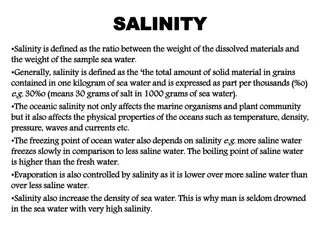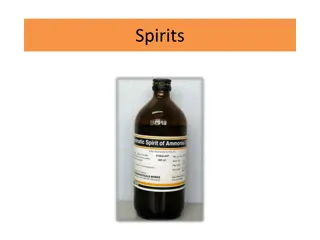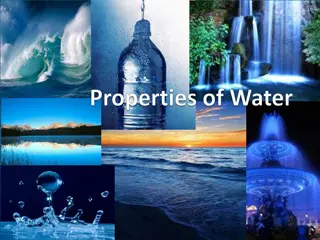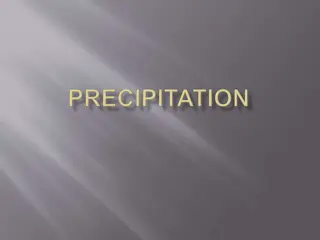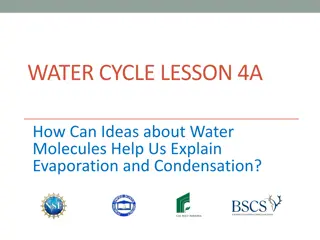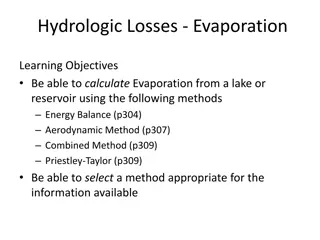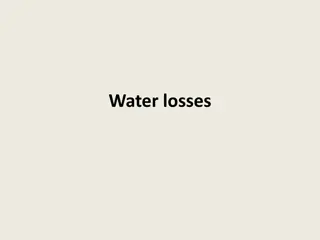Week at A Glance for Science
The sun, land, and water affect climate and weather. Analyze Earth's atmospheric layers, energy transfer processes, wind systems, and meteorological events. Investigate the sun's heat transfer and its influence on air, land, and water. Learn about air pressure, weather fronts, and the effects of oce
3 views • 9 slides
Understanding Interior Drainage Basins: Endorheic Systems and Dry Lakebeds
Explore the concept of interior drainage basins, including endorheic systems that do not drain to oceans but instead to closed basins. Learn about regions like the Great Basin, Sahara Desert, and Tarim Basin in China. Discover dry lakebeds such as the Great Salt Lake in Utah and Salar de Uyuni in Bo
3 views • 10 slides
The lacrimal system
Disorders of the lacrimal system can lead to chronic symptoms affecting the eyes, causing discomfort and vision problems. Common abnormalities include dry eye, which can result from tear flow and evaporation issues. Aqueous-deficient dry eye, often associated with Sjögren's syndrome, is characteriz
3 views • 38 slides
Understanding the Water Cycle and Its Importance in Nature
Water is essential for all life on Earth, continuously moving through different physical states in a cycle that has been occurring for over 4 billion years. The Water Cycle involves processes like evaporation, transpiration, condensation, precipitation, and collection, ensuring water is always movin
11 views • 7 slides
Advanced Technology in Dark Matter Research
Cutting-edge technologies such as multi-source TPB evaporation, LAr TPC, and DarkSide-20k TPC are being utilized in the study of dark matter. These technologies aim to enhance detection sensitivity and uniformity in film coatings, crucial for advancing our understanding of mysterious dark matter par
1 views • 20 slides
Understanding Evaporation in the Food Industry
Evaporation, a key process in the food industry, involves removing excess water from raw materials or processed foods to enhance preservation and reduce costs. It requires considerations such as heat transfer, temperature control, and prevention of overheating. Evaporation differs from dehydration a
0 views • 22 slides
Exploring Quantum Black Holes: Dual Dynamics and Brane Evaporation
Exploring the dual dynamics of quantum black holes reveals new perspectives on black hole evaporation. By placing black holes on branes, we can study their classical picture in higher dimensions. This approach provides insights that were previously unattainable, leading to a better understanding of
1 views • 28 slides
Understanding Salinity in Seawater and Its Impacts
Salinity is the ratio of dissolved materials to the weight of seawater, affecting marine life and physical ocean properties like temperature, density, and waves. It influences freezing and boiling points, evaporation, and water density. Seawater composition includes salts like sodium chloride, magne
0 views • 11 slides
Investigating Different Liquids Evaporation Rates
This project aimed to determine if different liquids evaporate at the same rate. Through experiments with various liquids like tea, water, lemonade, Pepsi, and orange juice, it was observed that not all liquids evaporate at the same speed. The hypothesis that adding ingredients to water would slow d
0 views • 15 slides
Understanding Spirits: Types and Uses
Spirits are alcoholic or hydro-alcoholic solutions of volatile principles, mainly volatile oils, classified into therapeutic and flavoring types. They are prepared by distillation or dissolving volatile substances in alcohol, with varying alcohol content. Proper storage in light-resistant containers
1 views • 20 slides
The Fascinating World of Water: A Vital Element for Life
Water is essential for life on Earth, constituting about 70% of the planet's surface. With its unique chemical makeup (H2O) and properties, water exists in three states and undergoes various physical changes. Fun facts like water's unusual behavior when it freezes add to its allure. Understanding th
1 views • 15 slides
Understanding States of Matter: Energy and Changes
Explore the energy differences between the states of matter, learn about the properties of solids, liquids, and gases, and understand how energy affects state changes through melting, freezing, evaporation, condensation, sublimation, and deposition. Discover the roles of chloroplasts, cell walls, an
0 views • 10 slides
Understanding the Water Cycle and Environmental Conservation
Explore the water cycle processes like evaporation, condensation, precipitation, and accumulation. Learn about watersheds, pollution, resources, leaks, and the importance of conservation. See how fertilizers impact plants and how to conserve natural resources effectively.
0 views • 11 slides
Understanding Precipitation in Meteorology
Precipitation in meteorology is the result of atmospheric water vapor condensing and falling to Earth, a vital element of hydrology. It can occur in liquid or solid forms through processes like evaporation, cooling, condensation, and droplet growth. Different geographic and climate conditions impact
0 views • 17 slides
Explaining the Water Cycle: Nature's Recycling Process
The water cycle, a crucial natural phenomenon, illustrates how water circulates in the environment. Evaporation, condensation, and precipitation are key stages that define this continuous process, sustaining life on Earth.
0 views • 12 slides
Adaptation of Animals to Hot Climates - Understanding Thermal Regulation Strategies
Animals have evolved remarkable adaptations to cope with hot climates, including physiological responses such as sweating and changes in body size and limb length. Temperature stress can affect their functioning, making thermoregulation crucial. Bergmann's rule and Allen's rule explain how body size
0 views • 15 slides
Understanding the Hair Growth Cycle and Structure
Hair is a protein filament that grows from follicles in the skin, playing essential roles in thermal regulation, protection, and facilitating perspiration evaporation. The hair consists of layers like the medulla, cortex, and cuticle, each with specific functions. Hair growth follows a cyclic proces
4 views • 23 slides
Distillation Process and Applications in Food Industry
Distillation is a separation process used in the food industry to separate components in a mixture based on their volatility. It involves vaporization, condensation, and re-evaporation to achieve separation. Steam distillation is a method where steam is used to reduce boiling temperatures for safe s
1 views • 13 slides
Principles and Applications of Multiple Effect Evaporators in Chemical Engineering
This article discusses the operation and design principles of multiple effect evaporators in the context of chemical engineering. It covers the heat transfer mechanisms, efficiency considerations, and calculations involved in these systems, highlighting the benefits of utilizing multiple effects for
0 views • 11 slides
Understanding Atmospheric Moisture in Physical Geography
Atmospheric moisture, in the form of water vapor, liquid water, and ice, plays a crucial role in shaping weather and climate. This course delves into the dynamics of atmospheric moisture, including its distribution, effects on weather patterns, and impact on various climatic factors such as precipit
0 views • 7 slides
Understanding Plant Evaporation and Transpiration Processes
Learn about the structural differences between xylem and phloem vessels, the role of stomata in plant leaves, and how water loss occurs through transpiration. Discover how guard cells regulate stomata openings and watch a video explaining transpiration processes in plants. Test your knowledge with s
0 views • 11 slides
Distillation Process for Purifying Water
Distillation is a method used to purify water by separating it from impurities through evaporation and condensation. It involves heating the water until it evaporates, then cooling the vapor to collect the purified water. This process ensures the removal of harmful substances and microbes, resulting
1 views • 11 slides
Crystallization Process in Chemical and Petroleum Industries
Crystallization is a purification method used in industries to produce crystalline materials like sugar and citric acid. It involves nucleation and crystal growth stages. Key terms include nucleation, solubility, and supersaturation, impacting crystal formation. Various methods like cooling, evapora
1 views • 19 slides
Understanding Losses in Irrigation Systems: Measurement Methods and Techniques
Losses in irrigation systems, including seepage and evaporation, are major concerns impacting water conservation. This article discusses historical estimates of losses, types of losses (seepage and evaporation), methods used to measure losses (direct and indirect), and detailed information on seepag
6 views • 29 slides
Understanding Evaporation in Chemical and Petroleum Industries
Evaporation is a process of vaporizing a solvent to produce concentrated solutions used in various industries like sugar, salt, and chemical production. This article covers the principles, purposes, and types of evaporators used in the field. It explains single and multiple effect operation methods,
13 views • 11 slides
Understanding Evaporation Principles in Sugar Processing
Evaporation plays a crucial role in sugar processing by removing water from solutions to concentrate sucrose. This process involves boiling liquor, vaporizing water through heat, and crystallizing sucrose. Learn about the boundary between evaporation and sugar boiling, quantity of water to be evapor
5 views • 38 slides
Understanding the Evaporation Process in Concentrating Solutions
Evaporation is a process used to concentrate solutions by removing a volatile solvent, often water, leaving behind a liquid residue. This method differs from distillation and drying, with considerations for liquid characteristics like concentration, foaming, temperature sensitivity, scale, and mater
1 views • 37 slides
Engineering Hydrology Course Overview and Great Salt Lake Evaporation Analysis
Engineering Hydrology course led by David Tarboton covers principles of hydrology, water balance concepts, and hydrologic modeling. The analysis of Great Salt Lake evaporation explores factors such as inflow, area, and precipitation to determine the average annual evaporation rate.
1 views • 18 slides
Overview of Physical Vapor Deposition (PVD) Techniques in Thin Film Deposition
Physical Vapor Deposition (PVD) includes various vacuum techniques for depositing thin films on substrates through physical means. This method involves a dry vacuum process to coat objects with different materials. PVD processes utilize methods like Mechanical, Evaporation, Sputtering, Ion plating,
0 views • 31 slides
Understanding Evaporation and Condensation Through Water Molecules
Exploring the water cycle and states of matter, this lesson delves into how ideas about water molecules aid in explaining evaporation and condensation. Through diagrams, simulations, and real-life scenarios, students learn about the movement and changes of water molecules. By comparing their ideas w
0 views • 12 slides
Understanding Boiling and Evaporation of Liquids
Learn about the process of boiling and evaporation of liquids, including how liquids transform into gases, the role of temperature in these changes, examples of evaporation in daily life, and fun experiments to explore drying times. Discover the three states of matter and the significance of water v
0 views • 10 slides
Advanced ORC Architectures for Waste Heat Recovery at IIT Madras
Presentation of a novel Trans-critical Regenerative Series Two-Stage Organic Rankine Cycle (TR-STORC) by researchers Anandu Surendran and Satyanarayanan Seshadri at the 5th International Seminar on ORC Power Systems in Athens. The TR-STORC layout combines supercritical evaporation in the high-pressu
0 views • 21 slides
Hydrogeology and Water Resource Management Problems
The content contains four challenging problems related to hydrogeology, evaporation, watershed hydrology, and flood control reservoir operations. It covers topics such as water table rise, evaporation rate calculation, unit hydrograph analysis, detention basin filling, and reservoir inflow routing.
0 views • 4 slides
Understanding Mixtures and Separation Methods
A mixture is a combination of ingredients that can be separated by various methods like sieving, filtering, and evaporation. Magnets are also used to separate magnetic objects. Sieving separates solid particles by size, while filtering separates tiny particles from liquids. Evaporation is used for s
0 views • 14 slides
Understanding States of Matter: Kinetic Molecular Theory and Phase Transitions
Exploring the fundamental concepts of the states of matter, this content delves into the Kinetic Molecular Theory, explaining how matter changes from solid to liquid to gas based on particle movement and energy levels. It further discusses the nature of gases and liquids, vaporization, evaporation,
0 views • 17 slides
Microgravity Evaporation Study by Thomas Edison Energysmart Charter School
Evaporation Investigation Mission 7 Project led by students from Thomas Edison Energysmart Charter School in NJ explores the effects of microgravity on water evaporation from the human body and foods. The study aims to understand differences in evaporation in space and on Earth to assess food freshn
0 views • 9 slides
Understanding the Water Cycle: Evaporation, Condensation & Precipitation
Explore the water cycle process through evaporation, condensation, and precipitation. Learn how air temperature affects water vapor, leading to the formation of rain and snow. Discover the importance of energy in driving the water cycle and observe examples of these phenomena in nature.
0 views • 53 slides
Understanding Evaporation Methods and Implications in Hydrology
Learn how to calculate evaporation using various methods such as Energy Balance, Aerodynamic Method, Combined Method, and Priestley-Taylor. Understand the importance of evaporation and transpiration in the hydrological cycle, climate change predictions, and water availability for ecosystems and agri
0 views • 10 slides
Engineering Approach to Enhancing Water Availability in the Mediterranean Basin
Explore an innovative engineering approach to addressing water scarcity in the Mediterranean Basin through regreening degraded areas using sea water evaporation technology. This presentation discusses the impact on convective triggering, surface evaporation, and technology development for sustainabl
0 views • 24 slides
Understanding Water Losses and Evaporation in Hydrology
The hydrological equation explains the various factors contributing to water losses, including interception by vegetation, evaporation from water and soil surfaces, transpiration, evapotranspiration, infiltration into soil, and watershed leakage. Evaporation is influenced by temperature, humidity, w
0 views • 20 slides







